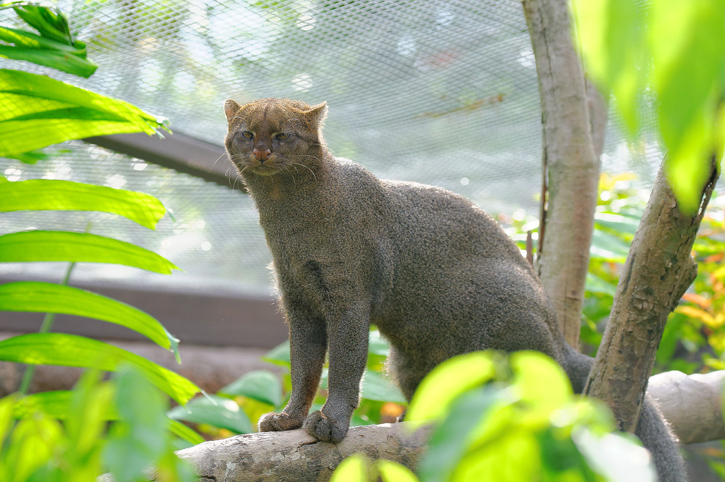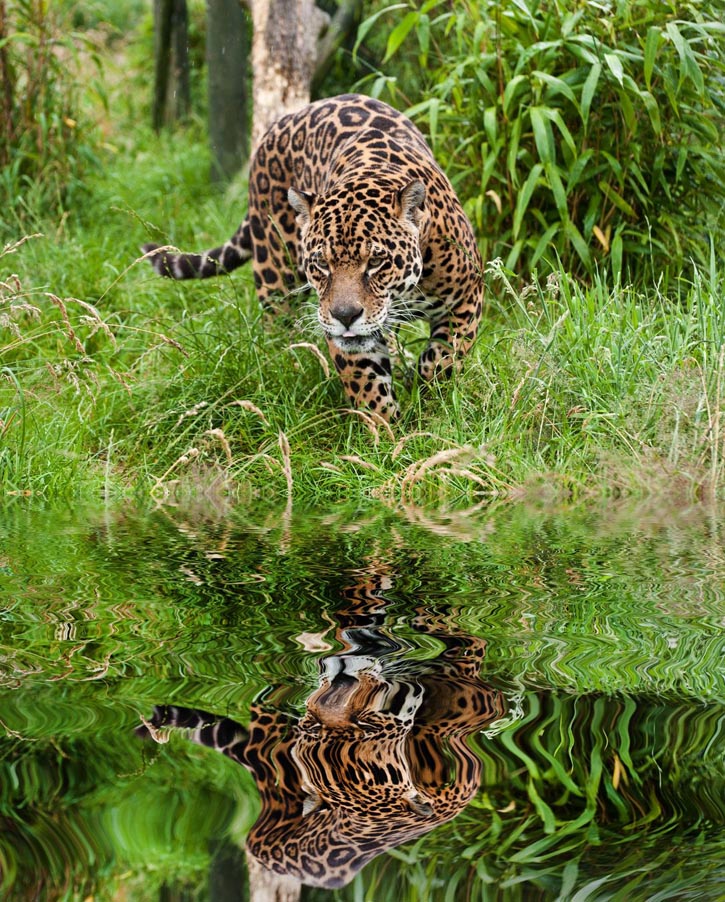Costa Rica boasts six endangered members of the cat family. All are active by day and night but are rarely seen. Cats are primarily solitary and nocturnal and spend the greater part of the day sleeping or hidden in dense vegetation. Although they are legally protected, hunting of cats still occurs in Costa Rica. However, the main threat to the remaining populations is deforestation.

The jaguarundi is about the size of a large house cat and its hind legs are taller than its forelegs. Photo © Jordan Tan/123rf.
One of the most abundant of cats is the jaguarundi (called león breñero locally), a spotless dark-brown or tawny critter about the size of a large house cat. It has a long slender body, short stocky legs (its hind legs are taller than its forelegs), long tail, and a venal face with yellow eyes suggesting a nasty temperament. It is more diurnal than its cousins and is sometimes seen hunting in pairs, preferring lowland habitats.
The puma (león) also inhabits a variety of terrains, though it is rarely seen. This large cat—also called the “mountain lion”—is generally dun-colored, though coloration varies markedly among individuals and from region to region.
When roads penetrate the primeval forest, the jaguar is among the first large mammals to disappear.The spotted cats include the cute-looking, house-cat-sized margay (caucel) and its smaller cousin, the oncilla. Both wear an ocher coat spotted with black and brown spots, like tiny leopards. Their chests are white. The solitary and strongly nocturnal margay, which can weigh up to six kilograms (13 pounds), has a very long tail in relation to its body size, which, combined with its ability to turn its hind feet by 180 degrees, provides monkey-like climbing abilities. It is found only in primary or very little-disturbed forests. The oncilla or tiger cat has black ears and is distinguished from the margay by its face, closely resembling that of a domestic cat, its shorter tail, and more slender body shape. This solitary animal prefers montane cloud forest.The most commonly seen cat is the ocelot (manigordo), which is well distributed throughout the country and among various habitats. The ocelot is the biggest of Costa Rica’s “small” cats—males can weigh up to 15 kilograms (33 pounds), the females up to 11 kilograms (24 pounds)—and has short, dense fur with brown spots and rosettes with black edges, arranged in parallel rows along its body length, with a background of grayish-yellow. It has a characteristic white spot on each ear, and black stripes on both cheeks and forehead.
Worshiped as a god in pre-Columbian civilizations, the jaguar is the symbol of the Central American rainforest. Panthera onca (or tigre to locals) was once abundant throughout Central America. Today, this magnificent and noble beast is an endangered species, rare except in parts of the larger reserves: Santa Rosa, Tortuguero, and Corcovado national parks, and the Cordillera Talamanca. When roads penetrate the primeval forest, the jaguar is among the first large mammals to disappear. While a few of the famous black “panther” variety exist, most Central American jaguars are a rich yellow, spotted with large black rosettes.

Jaguars are an endangered species, rare except in parts of the larger reserves: Santa Rosa, Tortuguero, and Corcovado national parks, and the Cordillera Talamanca. Photo © Matthew Gibson/123rf.
Jaguars are the largest and most powerful of the American members of the cat family—a mature jaguar measures over two meters (6.5 feet), stands 60 centimeters (24 inches) at the shoulders, and weighs up to 90 kilograms (200 pounds). The animal’s head and shoulders are massive, the legs relatively short and thick. An adept climber and swimmer, the beast is a versatile hunter, at home in trees, on the ground, and even in water. Like all wild cats, jaguars are extremely shy and attack humans very rarely.
Excerpted from the Tenth Edition of Moon Costa Rica.